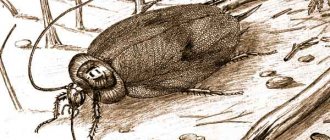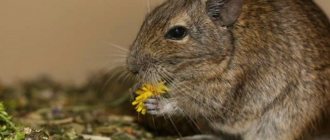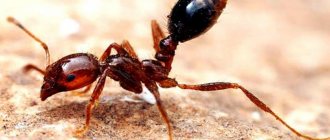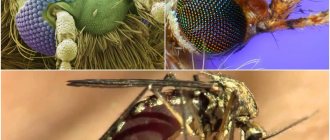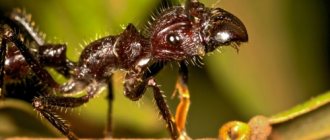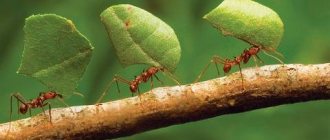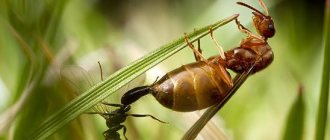Interesting facts about ants
Comparison of ants of different species
Ants constitute almost 2% of the total species diversity of the animal world and up to 80% of the biomass of insects (about 20% of the biomass of all animals). In temperate and tropical forests, ants provide soil movement and aeration.
In tropical rainforests, 99.9% of nutrients would remain in the top layer of soil if they were not transported deeper, including by ants. Ants, along with termites, can increase crop yields in regions with dry and hot climates where earthworms are absent. In experimental conditions in Australia, they increase wheat yield by 36%.
Ants are one of the most powerful biological agents of mineral erosion and record holders for capturing carbon dioxide from the atmosphere. Under the influence of ants, the process of converting minerals such as limestone, marble and chalk into calcium and magnesium carbonate (MgCO3 and CaCO3) is accelerated by 50 to 300 times. This ant-driven mineral erosion may have played an important role in the Cenozoic cooling of the Earth.
In some parts of the world (mainly Africa and South America), large ants, especially nomadic ants, are used to stitch wounds during surgical operations. The jaws of the ants grasp the edges of the wound and fix them in place. The body is then cut off, but the head and jaws remain, helping to close the edges of the wound.
Peculiarities
The Ant cargo scooter is quite easy to maintain. If it breaks, you can turn it on its side and make repairs or replace parts. However, it cannot be called economical, since a 2-liter single-cylinder engine consumes as much as 8 liters per 100 kilometers, and after wear of the piston system it is 10 liters. However, at that time the cost of gasoline was low, so there were no problems with operation.
The simplicity of the motorcycle’s structure does not require any special knowledge of a mechanic, because even to remove the tire there is no need to re-mount it. Simply unscrew the bolts located in a circle. These types of features of the moped allow repairs to be made anywhere, without special equipment. Which is very convenient, because it’s no secret how often Soviet equipment breaks down. However, in case of serious engine and chassis breakdowns, which occur quite often, the knowledge of a mechanic is sometimes simply necessary.
If necessary, you could choose a moped with the most suitable configuration. Thus, models with an additional seat for a passenger and models with a closed body were released.
The Ant scooter currently has many analogues in Asian countries. Road congestion in Asia has made the cargo moped one of the most popular models for hard workers. It allows you to easily navigate narrow alleys and significantly reduces travel time. The Chinese analogue and the original Ant scooter, although they do not have significant differences in appearance, are strikingly different in quality.
Types and their weight
The weight of an ant depends on its species:
- pharaoh ant (house ant, ship ant) - 1-2 mg;
- formycins (black or red) - 5-7 mg;
- working large tropical ant - 90 mg.
The queen of African nomadic ants can gain weight up to 10 g during the sedentary period of life. At this time, she lays up to 120 thousand eggs every day. She is a record holder for fertility. No one from the animal world can compare with her in this matter.
Soldiers (dinergates) of leaf cutters weigh 20-30 times more than other workers of this family, and their uterus weighs 700 times more. Dinergates are capable of setting more remarkable records in terms of how much weight they lift, but they don't do it. Their main duty is to protect the “cargo carriers”, and not to carry heavy loads.
How much weight an ant lifts depends on its own size. But the principle that ants often operate is that the ratio of the weight lifted to the body weight of the hymenoptera increases as the size of the insect itself becomes smaller.
Is it possible to use "ant power"?
In Central Africa, the powerful jaws of ants are used to stitch open wounds on the body: the two edges of the wound are pressed against each other and an angry ant’s head is applied to them, like a stapler. The insect immediately clenches its jaws and tightly squeezes both edges of the skin. A few of these ants - and the seam is ready. It is only important to cut off the ant’s head with scissors as soon as possible: after this the jaws will no longer open.
Sometimes in Africa, the natives extract tasty seeds and small nuts from anthills, using ants as collectors. However, the natives are incredibly ethical in this regard - instead of supplies taken from the anthill, they leave pieces of dried meat or fruit for the insects. They know that if nature is not robbed, but shared equally with it, it will reward it many times over.
How much does an ant weigh?
First of all, ants' ability to lift such heavy objects is ensured, oddly enough, by their low weight. Why is this happening?
Let's first define the ant mass. Residents of ordinary anthills , red or black, which inhabit the forests and fields of central Russia, and also spoil our vegetable gardens and orchards, weigh about 5–7 milligrams. There are also smaller varieties - for example, the weight of the pharaoh ant, a well-known household pest, is 1 milligram, and some tropical species weigh the same.
Reasons for the appearance of ants in the apartment
However, this is the mass of the lightest individuals - workers, that is, females with an undeveloped reproductive system. The mass of a soldier ant is several tens of times greater than the mass of a worker ant, and the queen ant is 200 or even 500 times heavier than an ordinary worker. True, from the point of view of carrying capacity, the queen does not interest us - she does not have to lift weights, this is what the bulk of the population of anthills does. Therefore, it is more important for us to know how much the lungs weigh, rather than the queens.
At the same time, larger species of ants are also found on Earth - for example, a working individual of the South American bullet ant gains weight up to 90 milligrams, which is approximately 20 times the mass of an ordinary forest ant.
What is the power of ants
Here it is necessary to note the fact that we are talking not only about ants, but about all insects in general. Absolutely all insects can develop enormous strength and power. The same fleas very quickly push their body over a distance 150 times their body length. And scarab beetles can lift up to 850 times their body weight. After such examples, even the strength of an ant seems very insignificant.
The reason for such phenomenal abilities of ants and insects in general has long been explained by scientists. In the animal world, there is a law according to which, when the geometric dimensions of the body of a living creature decrease, its mass decreases in proportion to the length of the body to the third power, and the cross-sectional area of the muscles decreases in proportion to the square of the body length.
It's a little complicated, but this means that ants have muscles 100 times stronger per unit mass than humans. And this proportion is also observed for other living beings - crustaceans, fish, mammals. And in addition, the exoskeleton and a slightly different muscle structure bring their own premiums into these calculations.
This does not at all mean that the smallest ant is the strongest. Here everything is the other way around - the largest ant is the strongest.
How many times does an ant lift more than its own weight?
These small insects have enormous strength and endurance. As children, we were all told that an ant can lift 10 times its own weight. In fact, this is a huge understatement of its capabilities!
Scientists have found that they are able to withstand a weight 50 times greater than the mass of an ant. In addition, when several individuals combine their efforts, this figure increases.
If a person had such strength, he could lift a weight of about 4-5 tons.
Interesting! To lift and transport one person, you will need the strength of about 10 million ants.
But why does an ant lift more than its own weight? This is explained by the fact that as the size of a living organism decreases, the percentage of muscles per unit of mass increases. It turns out that the ant's muscles are stronger than those of any person.
The strength of ants allows them to cope with the complexities of the world around them. Most objects around will be significantly larger than their size. In such a situation, even an ordinary leaf becomes a heavy burden. Objects of complex shape that the ant is not able to lift, it can drag behind it for a long time.
These abilities have many uses. Some species of ants are capable of creating real living bridges, tightly intertwining their legs. So, clinging to each other, they can cross streams or rivers. Such an ant structure can withstand a weight of several kilograms.
Now you know how strong these insects are and how much weight an ant can lift. But no matter how amazing these creatures are, their hard work and tenacity of ants can become a serious problem if they are found in your home.
How much weight does an ant lift?
Today it has been verified that on average an ant lifts a weight that is 50 times greater than its own - for example, each working leaf-cutter ant carries up to 100 mg. Knowing how much an ant weighs, you can calculate what it is capable of, like a weightlifter.
Interestingly, the soldiers of leaf-cutter ants weigh several dozen times more than ordinary workers, and the queen weighs 700 times more! Naturally, in this species, soldiers appear only in those anthills whose number exceeds 100 thousand individuals - it is difficult for a smaller number of workers to feed such an army.
In principle, a soldier of this type could set a more outstanding record, but he never does this: his task is not to carry loads, but to protect the “loaders.”
On a note! If a person could lift weights in the same proportions as ants do, he could easily press a barbell over his head up to 5 tons. That is, the strength of an ant is approximately 25 times greater than that of a human.
As mathematicians cleverly calculated, it would take about a million ants to carry an adult, and about 10 thousand to carry a glass of beer.
Of course, the results of such measurements depend on the type of ant and how much each of them weighs.
Of course, the smaller the ant, the less mass it lifts. However, the ratio of the weight lifted to the mass of the ant itself increases as the size of the insect decreases.
This is interesting! When carrying heavy loads together, the ants' abilities increase even more. During laboratory experiments, an ant alone developed a power of 24.2 erg/sec, and two ants together developed a power of 63.2 erg/sec. That is, an ant can lift as much in cooperation with a comrade as they both cannot lift on their own combined.
What other abilities do they have?
Ant power, which never ceases to amaze the human imagination, is expressed not only in how many loads this insect can lift. Ants are also very inventive, and they also have other incredible abilities.
Hymenoptera put a lot of effort into caring for their offspring. The safety of future generations is their priority.
Insect bridges
African ants not only amaze with the amount of load they carry, but also with their ability to build living bridges. If they encounter a water obstacle, the working individuals quickly construct a bridge from their own bodies. This allows the queen and larvae to safely cross to the other side.
Visually, the bridge design looks very unusual. It's amazing how many Hymenoptera create it. Several hundred ant individuals at once firmly adhere to each other. In this position they maintain a static position until all the larvae and the queen are safely away from the water.
Dragging along the ground
No matter how much weight an ant is able to lift, this is not always possible due to the awkward shape of the object, so they often simply diligently drag their find along the ground. Also, the need for this may arise when an insect finds an object that is too large, which, even if it wants to, cannot be lifted above itself.
Scientists say that if we continue to study how much weight an ant can lift , as well as its other features, then in the future this will help design equipment and robots. Such innovative developments will make it possible for products to easily lift weights that will be many times greater than their own weight.
Ant abilities
However, the strength of ants is determined not only by the weight they can lift. Ants use their physical abilities in other ways.
For example, ant bridges are very well known, which are organized by working individuals of African nomadic ants to transport larvae and the queen across water barriers. Several hundred ants grip each other's bodies so tightly that a mammal the size of a cat can cross across the constructed bridge to the other side of the stream. True, not a single animal tries to do this - these ants are extremely dangerous because of their painful bites.
And the same leaf-cutter ants can drag along the ground a load weighing 30 times their body weight. The need for this may arise when an insect, due to the non-standard size of an object, cannot lift it above its head.
Interestingly, especially inventive representatives of Homo Sapiens have learned to use many of these abilities of ants for their own purposes.
Ants build a bridge (video)
How do ants reproduce?
In general, ants reproduce only twice a year. they have two methods of reproduction:
- The female takes with her several individuals of worker ants (because it is the workers who are intended for the fertilization function) and leaves her “home” to create a new family.
- The female flies to another family of ants, where she is fertilized by other worker ants, after which she lays eggs.
The female takes with her several individuals of worker ants (because it is the workers who are intended for the fertilization function) and leaves her “home” to create a new family.
The female flies to another family of ants, where she is fertilized by other worker ants, after which she lays eggs.
After a while, the males that fertilized the female die, and the female feeds on the remains of her wings until the larvae hatch. Of those eggs that are fertilized, workers and females are born, and of those that are not fertilized, only males are born.
In general, ants are an insect that can be considered harmless, since they cannot harm human health. The only downside to having them in the house is that they run around the house and look for food. Ants should not be killed, as they destroy many harmful insects that interfere with life in everyday life (mosquitoes, moths, flies, and so on).
Ant food
Most ant species are predators. For normal development and functioning they need carbohydrates and proteins. The main consumers of protein are larvae, and carbohydrates are adults. Approximate diet of an ant:
- live and dead insects;
- honeydew (sweet secretions of aphids);
- juices of plants and fruits;
- mushrooms and dead animals;
- plants' seeds;
Foragers—working females—are engaged in obtaining food.
Ants breed aphids, for which they have shepherds and milkers. They protect their “herd” and look after it.
Many species of ants breed mushrooms for food. They set up gardens, fertilizing them with pieces of cut plants and carrion.
To search for food, foragers can move several hundred meters away from the nest. At the same time, they are able to find the shortest way back.
The role of ants in nature
- In general, ants are quite beneficial to the environment.
- Those ants that settle in dead wood can speed up the process of its destruction, thereby freeing the area from diseased trees.
- Ants are predators. During the summer season, ants are capable of destroying several million harmful insects.
- Ants are, in their own way, seed dispersers. When they carry them home, they lose some of the seeds along the way, thereby filling the forests with new plants and trees.
- Ants perform the function of pollinating various plants by extracting juice from them.
- When ants build their underground homes, they loosen the soil very well, thereby allowing plants to grow better there.
- If we talk about a vegetable garden or garden plot, then where there are black ants, we can say that the soil is of high quality.
- Various kinds of tinctures and ointments for treatment are produced from ants, thus we can say that ants are also used for medicinal purposes.
What does an ant eat in nature?
The diet is varied, its nature depends on the species.
Predator ants
The food of predator ants is exclusively of animal origin. They also feed the brood with it. Without protein food, the larvae are unable to develop.
Their diet:
- invertebrates;
- all kinds of insects, larvae;
- different size frogs;
- small lizards, but in large numbers they can attack a large individual;
- chicks that have fallen out of the nest;
- birds that don't fly;
- any wounded, immobilized animal,
- animal corpses.
Herbivorous ants
They prefer a plant-based diet. The options for eating food are different. So harvester ants grind food, moisten the resulting flour with saliva and eat this kind of dough. Carpenter ants digest food through endosymbiont bacteria in the gut. Leaf cutters grow mycelium, which they later eat.
Their diet:
- rotten wood,
- seeds of various herbs,
- roots,
- cereals,
- dry and ripe fruits, fruits, berries, vegetables,
- plant juice,
- nuts.
Omnivorous ants
- These types of ants are widespread in nature. They can eat any food of plant or animal origin. This is especially true for pharaoh or house ants. They eat everything from small invertebrates to seeds, cottage cheese and sweets.
- There is a division by age. Larvae are provided with food rich in proteins, and adults - carbohydrates, to quickly replenish wasted energy.
- Some ants breed aphids: they take care of them, protect them from predators, and protect them from bad weather. At the same time, the ants feed on aphid secretions - honeydew, which is obtained by tickling the abdomen of the aphid.
How much do Hymenoptera weigh?
In nature, there are more than 12,000 varieties of these hardworking ants, differing in size and appearance. So, depending on the species, the average weight of an ant ranges from 1-150 mg. Speaking about the ant workers of black and red forest insects, their weight is no more than 7 mg. The smallest weight of ants, called pharaoh ants, does not exceed 2 mg. The Siafu nomads are considered one of the largest and heaviest. The weight of an ant of this species is up to 90 mg.
Ant weight
Interesting!
The weight of the uterus of a wandering termite is equal to the weight of 200-700 working individuals. And this is not the only feature of the queen. Its lifespan can be up to 20 years. But the mass of a soldier ant, or as it is also called a “defender,” is tens of times greater than the weight of the workers. Although these species live much less than their queen.
Ant lifting capacity
Information about how much weight an ant can lift can greatly surprise a person’s imagination. Entomologists claim that this representative of the Hymenoptera lifts a weight that is 50 times greater than its own body weight. A good example is the leaf cutter. Knowing his weight, it is assumed that it is not difficult for him to bear weights that reach 100 mg.
But not only these ants have this ability. Representatives of another group of insects can also set similar records. Many Coleoptera push and pull loads that are many times their own weight. Orthoptera or blood-sucking parasites jump long distances. It is also a type of weight transfer because jumping requires you to lift your own body weight off the ground.
The leader in carrying heavy loads is the scarab beetle (dung beetle) . He lifts a weight almost a thousand times greater than his body weight. This is compared to what it would be like for a person to lift 6 double-decker buses at the same time.
Ant lifting capacity
How much can an ant actually lift? In absolute terms, not so much, but relative to the ant’s own weight , this is a huge burden. A type such as a leaf cutter is capable of carrying objects weighing up to 100 milligrams. This is 50 times more than the body weight of this insect. So how does an ant manage to lift a load and why are ants so strong?
In fact, such amazing abilities are also inherent in other species , so this insect cannot be considered the sole lightweight champion in weight lifting. Many beetles are capable of pushing and carrying weights many times greater than their own; grasshoppers and fleas are capable of jumping great distances, which is also a form of carrying weights - after all, in a jump you need to lift your own body off the ground.
The secret is that small living creatures have more muscles per unit area or body weight than large animals, including humans.
There is even a formula for calculating the cross-sectional area of muscles relative to body mass and length.
In addition, insects and crustaceans have a different skeletal structure and internal organs than mammals. This fact must be taken into account when calculating how much an ant can lift. Without going into details, let's say that on average this insect turns out to be 100 times stronger than a person. This is why an ant can lift a weight that significantly exceeds its own. Moreover, given the small size of these insects , in order to carry large objects, they need to combine their efforts. In the ant world, there is even a synergistic effect - two workers together can lift and carry more weight than both of them could carry separately.
